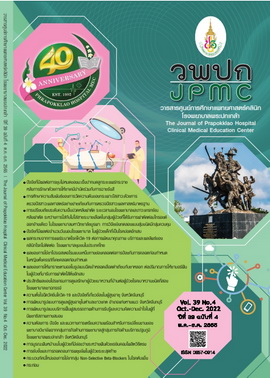Factors Affecting Incomplete Remission in Advanced Cervical Cancer after Concurrent Chemoradiation
Main Article Content
Abstract
BACKGROUND: Cervical cancer is the most common form of gynecologic malignancy and the fourth most common cause of death from female malignancy. Poor treatment outcomes and survival are typically due to late presentation in advanced stages. Determining the factors affecting incomplete remission in advanced cervical cancer after concurrent chemoradiation may provide a guideline for the management of further surgery or combination chemotherapy, before or between concurrent chemoradiation.
OBJECTIVE: We aimed to study the factors used to predict incomplete remission in advanced cervical cancer after concurrent chemoradiation (primary outcome).
METHODS: This study utilized prognostic factor research and a retrospective case-control design of advanced cervical cancer patients (stage II-IVA) (FIGO2019) who underwent concurrent chemoradiation at the Gynecologic Oncology Unit and Radiotherapy Unit at Surin Hospital, Thailand from 1 January 2011 to 30 April 2021 and received follow-up to 30 November 2021. We classified patients into 2 group comprising complete remission and incomplete remission after 1 month of concurrent chemoradiation. We collected the baseline characteristic data, stage, ECOG, size of tumor, lymph node metastasis, cell type of cancer, waiting time to start radiation, regimen and cycle of chemotherapy between radiation cause, history of oral contraceptive pills used, amount of parity and partner, drinking, smoking and previous CIN. Univariate and multivariable regression models were used for analysis.
RESULTS: A total of 852 patients were included, with 568 patients in complete remission and 284 patients in incomplete remission. Seven significant predictors for incomplete remission were identified: Stages 3 and 4, ECOG 2-3, low BMI level, tumor size >4 cm, cell type adenocarcinoma, lymph node metastasis and drinking.
CONCLUSION: Patients who exhibit these factors should receive neoadjuvant chemotherapy to decrease the size of a tumor before surgery. If surgery with free margins proves to be inoperable, radiation is the next step. The combination of a chemotherapy regimen and radiation is an interesting alternative.
Thaiclinicaltrials.org number, TCTR20220226001
Article Details

This work is licensed under a Creative Commons Attribution-NonCommercial-NoDerivatives 4.0 International License.
References
Bray F, Ferlay J, Soerjomataram I, Siegel RL, Torre LA, Jemal A. Global cancer statistics 2018: GLOBOCAN estimates of incidence and mortality worldwide for 36 cancers in 185 countries. CA Cancer J Clin 2018;68:394-424.
Bae HS, Kim YJ, Lim MC, Seo SS, Park SY, Kang S, et al. Predictors of radiation field failure after definitive chemoradiation in patients with locally advanced cervical cancer. Int J Gynecol Cancer 2016;26:737-42.
Meanwell CA, Kelly KA, Wilson S, Roginski C, Woodman C, Griffiths R, et al. Young age as a prognostic factor in cervical cancer: analysis of population based data from 10,022 cases. Br Med J (Clin Res Ed)1988;296:386-91.
Chen CC, Wang L, Lin JC, Jan JS. The prognostic factors for locally advanced cervical cancer patients treated by intensity-modulated radiation therapy with concurrent chemotherapy. J Formos Med Assoc 2015;114:231-7.
Lee JY, Kim YT, Kim S, Lee B, Lim MC, Kim JW, et al. Prognosis of cervical cancer in the era of concurrent chemoradiation from national database in Korea: acomparison between squamous cell carcinoma and adenocarcinoma. PLoS One [Internet]. 2015 [cited 2022 Feb 14];10(12):e0144887. Available from: https://www.ncbi.nlm.nih.gov/pmc/articles/PMC4682792/pdf/pone.0144887.pdf
Brinton LA, Reeves WC, Brenes MM, Herrero R, de Britton RC, Gaitan E, et al. Parity as a risk factor for cervical cancer. Am J Epidemiol 1989;130:486-96.
Roura E, Castellsague X, Pawlita M, Travier N, Waterboer T, Margall N, et al. Smoking as a major risk factor for cervical cancer and pre-cancer: results from the EPIC cohort. Int J Cancer 2014;135:453-66.
Sharma P, Pattanshetty SM. A study on risk factors of cervical cancer among patients attending a tertiary care hospital: a case-control study. ClinEpidemiol Glob Global 2018;6:83-7.
Xiao Y, Ren YK, Cheng HJ, Wang L, Luo SX. Modified glasgow prognostic score is an independent prognostic factor in patients with cervical cancer undergoing chemoradiotherapy. Int J ClinExpPathol 2015;8:5273-81.
Zreik TG, Chambers JT, Chambers SK. Parametrial involvement, regardless of nodal status:a poor prognostic factor for cervical cancer. ObstetGynecol 1996;87:741-6.
Lee YY, Choi CH, Kim HJ, Kim TJ, Lee JW, Lee JH, et al. Pretreatment neutrophil: lymphocyte ratio as a prognostic factor in cervical carcinoma. Anticancer research 2012; 32:1555-61.
Haraga J, Nakamura K, Omichi C, Nishida T, Haruma T, Kusumoto T, et al. Pretreatment prognostic nutritional index is a significant predictor of prognosis in patients with cervical cancer treated with concurrent chemoradiotherapy. MolClinOncol 2016;5:567-74.
Karlsson T, Johansson T, Höglund J, Ek WE, Johansson Å. Time-dependent effects of oral contraceptive use on breast, ovarian, and endometrial cancers. Cancer Res 2021;81:1153-62.

